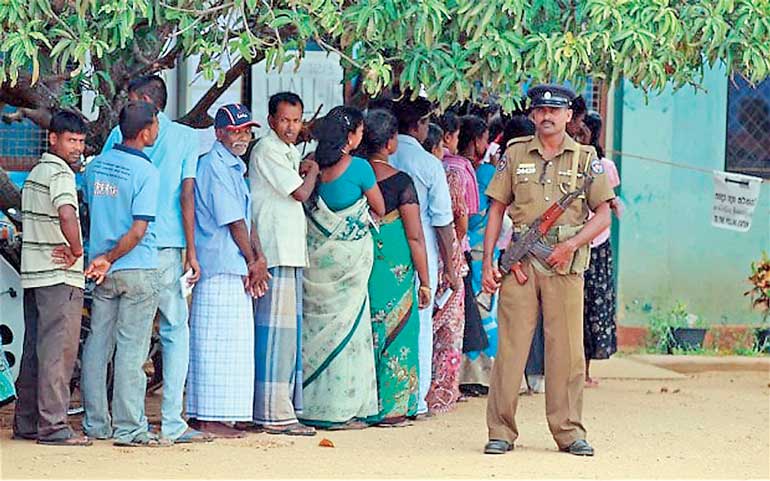Thursday Nov 27, 2025
Thursday Nov 27, 2025
Wednesday, 5 October 2016 00:02 - - {{hitsCtrl.values.hits}}
 In an ideal world, voters would vote for the best individual irrespective of ethnicity, but, with the country slowly emerging from the aftermath of a bitter ethnic war and continuing ethnic tensions, we cannot impose such egalitarian concepts on minorities
In an ideal world, voters would vote for the best individual irrespective of ethnicity, but, with the country slowly emerging from the aftermath of a bitter ethnic war and continuing ethnic tensions, we cannot impose such egalitarian concepts on minorities
Chief Minister of the Northern Province C.V. Vignesawaran may call for a ‘rise up’ of Tamils in the Northern Province, but the fact of the matter is that 56% of the Tamils in Sri Lanka live outside of the Northern Province. If you add Indian-origin Tamils to the mix, 68% of the Tamils live outside of the Northern Province dispersed in the other eight provinces. Similarly Muslims are concentrated in the Eastern Province, but 70% of the Muslims live outside of that Province.
The real ethnic issues in Sri Lanka is the ability of any ethnic community to live peacefully anywhere in Sri Lanka, including Muslims and Sinhalese living in the Northern Province. Due representation for dispersed communities in local or provincial councils and in the Parliament is essential for making such communities feel safe and accepted in their home environments.
The percent of minorities returned through the direct vote to the current Parliament is less than the percent of minorities in the population. However, the total minority representation in Parliament is more or less proportional to their percentage in the population thanks to an overrepresentation in the National List.
In the 2015 general election, for example, 40 out of 196 ‘district MPS’ returned were minorities, for a 20% rate of return for minorities, but 10 out of 29 National List MPS returned were minorities for a 34% return rate in the National List. The final minority count in the current Parliament is at 22%, closer to the rate of 25% of minorities in the population as per the Census of 2012.
Proposed MMP system
Under the proposed MMP or Mixed-Member Proportional system, 231 Seats in the Parliament will be allocated to qualifying Parties proportionate to the percent of votes received by each at the provincial or national level. The seats will be filled first by individuals who are returned first-past-the-post from 140 constituencies which are yet to be demarcated. The rest of the seats due to a Party are to be filled from closed and ranked Party Lists submitted as part of the nomination process.
The ballot will be of two parts. In the first called the Party Ballot, one would vote for a Party as we do now. In the second ballot called the Constituency ballot, a voter is able to vote for a representative for his/her Constituency out of a list of candidates from each political Party. Individuals too may submit nomination for any given electorate as independent candidates.
The proposed system fulfils the promises made by the two major Presidential candidates at the 2015 Presidential election or by the two major Parties at the 2015 general election to bring about reforms that reduce intra-party rivalry and the cost of elections and make MPs more accountable to the voters. However, the proposed system poses problems for dispersed minorities.
 Minority representation – present v. proposed
Minority representation – present v. proposed
Twenty-two out of the 50 minority MPs in the current Parliament were returned from preferential votes received by them through their candidacy within the two major political Parties. Their success is largely due to the fact that minority voters per district would give at least one of their preferential votes to a candidate of the same ethnicity. Therefore the current electoral district averaging about 680,000 voter per district is advantageous to minority candidates in the two major Parties.
In the proposed system, present electoral districts will be sub-divided into smaller constituencies with an average of 107,000 voters per unit. If the number of constituencies or electorates due to the Kandy district, say, is ten, mock demarcations carried out by us show that the population of minorities in each of 10 constituencies will be in the range of 10%-29%.
Since only one MP per Constituency is to be returned by popular vote, it will not be possible to return any Tamil or Muslim MPs on a FPP basis from the Kandy District unless the major Parties are able to find candidates of sufficiently cross-ethnic appeal. In the event no minorities are presented as FPP candidate by the two major Parties, a Tamil voter in Delthota or a Muslim voter in Nawalapitiya, say, is likely to be presented with a ballot paper with no viable choices in terms of ethnicity. This would be the same for the Badulla district in the Uva province where 27% of the population is non-Sinhalese.
In an ideal world, voters would vote for the best individual irrespective of ethnicity, but, with the country slowly emerging from the aftermath of a bitter ethnic war and continuing ethnic tensions, we cannot impose such egalitarian concepts on minorities. The long term view would be to make the integrity of a candidate and polices represented by his or her Party matter more than ethnicity. Until such time minorities should have the choice of voting along ethnic identities if they so choose.
Space for minorities in Party Lists
The Party List is indeed the space for candidates representing minorities. If we take the unit of PR calculation to be the Province, then the Central Province as a whole, for example, is expected to receive 36 Constituency seats or FPP seats and 24 Party Ballot seats or List seats, more or less. In order to give dispersed minorities their due representation, it is important that we pay special attention to the manner in which these List seats are filled.
We already have a provision in the Constitution that pays attention to ethnicity. For example, Article §99A of the Constitution ‘prescribes’ that:
“The Commissioner of Elections shall before issuing the aforesaid notice [regarding the returning of 29 National LIST MPs] shall determine whether the number of members belonging to any community, ethnic or otherwise, elected to Parliament under Article 98 is commensurate with the national population ratio and request the Secretary of such recognised political party or group leader of such independent group in so nominating persons to be elected as Members of Parliament to ensure as far as practicable, that the representation of all communities is commensurate with its national population ratio.”
It is not clear whether the Commissioner of elections ever sent back a list for its lack of representation, but as stated before, the major political Parties have always given over representation to minorities in the National List of 29 MPs. With the number of List MPs increased to 91, it is now more important than ever to have a mandatory rather than a prescriptive language regarding the ethnic distribution in the selection of List MPs.
If we apply the proposed new electoral method to the pattern of votes received by each Party in the general election of 2015 in the Central Province say, we can envision a scenario where the UNP wins 16 seats in PR but 15 seats in FPP contests, allowing the  Party to return only one candidate as a List MP. In contrast, the UPFA would have won 12 PR seats of which only three would be filled by FPP winners, leaving 9 List seats for UPFA.
Party to return only one candidate as a List MP. In contrast, the UPFA would have won 12 PR seats of which only three would be filled by FPP winners, leaving 9 List seats for UPFA.
In theory, a closed and ranked list would give due representation to minorities, but the small number of List seats available makes the situation tenuous for minority candidates included in the List. Sorting the list into ethnic groups with ranking within each group, and making it mandatory that ‘National’ Parties meet ethnicity based targets in each province, one would assure minorities their due place in the Parliament. A working definition for national party would be any Party that contests in 3 or more provinces.
An inclusive ballot paper too is needed
Preliminary calculations show that ethnic quotas for Parliament is indeed implementable, but the minority voter may still feel alienated from the electoral process. For example, a Tamil or Muslim voter in the Kandy district in the central province on entering the voting booth is likely to get a ballot paper with a list of Parties in the Party Ballot and a list of mostly Sinhala candidates in the Constituency ballot.
One solution would be to require all national Parties to include the names of highest ranked List candidate from each of the three major communities in the Party Ballot. The three communities would Sinhalese, Tamils (including both Sri Lankan and Indian-origin categories) and Muslims. Such a requirement would induce political Parties to present minorities with local appeal in their Lists, and voters would get a chance to see the names of the highest ranks minority candidates in the ballot paper itself. The ballot papers in Germany has a provision for listing the top three List candidates in the ballot paper, but ethnicity is not a concern in that country.
Sunset clause for ethnicity-based provisions
Above proposals require that candidates for public office identify themselves by their ethnicity. In the long term, the objective of constitutional reforms including electoral reforms would be a population with a Sri Lankan identity that goes beyond ethnic identities. Therefore, it would be best to put a sunset clause on these ethnicity based mandates.
An advantage of the FPP component in Mixed Member electoral methods is the fact that a candidate would ignore minorities in a Constituency at the peril of losing their votes to the opponent and losing the FPP contest. On the other hand minority candidates too have a chance of representing an electorate if they demonstrate ability to serve the electorate as a whole. Therefore, we can expect more and more racial harmony in an MMP system, but we need to ensure that minorities do not feel excluded on our way there.
Minority issues are too important to be left to minorities. A wider discussion involving all stakeholders is needed.